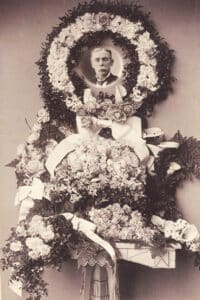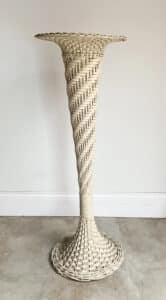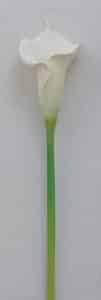by Judy Gonyeau, managing editor

The arrangement and placement of flowers around the dead are considered the oldest act of mourning. During the 1951 excavation of the Shandiar Cave in Northern Iraq, Dr. Ralph Solecki discovered several burial sites. Solecki submitted soil samples from the graves for pollen analysis to a paleobotanist who found pollen and flower fragments from at least eight species of wildflowers. The burials had occurred around 62,000 B.C. and neither birds nor animals could have been responsible for the placement of the flowers. It was concluded that someone 62,000 years ago had roamed the mountainside in the mournful task of collecting flowers for the funeral tribute.
Flowers as the Symbol of Life
The lifespan of flowers has long been equated to the lifespan of mankind—from seedling to full bloom to old age and death—people could follow the cycle of life within just a few weeks or months. Some note that the presence of fragrant and colorful flowers was a necessity to keep certain scents at bay as the dead are honored – sometimes over the course of weeks.
In a famous example, the 1874 funeral of President Andrew Johnson demonstrates the need for fragrance. His body was not embalmed, and by the day of his funeral, his body was in such foul condition that undertaker Lazarus C. Shepard closed the casket and heaped loads of fragrant flowers on top and around the burial receptacle. The fragrance of the flowers hid the odor long enough for the funeral to take place.
For many, the beauty of flowers and colorful arrangements helped to soften the perceived ugliness of death, allowing the viewer to avoid a shock when viewing the body. The viewing was meant to show the deceased as closer to the heavens, comforted by beauty and light.
The Wreath

(Amer. 1839-1912 in 1870 shows
a faithful dog at his master’s or mistress’s door where a memorial wreath with pink roses hangs
Often, wreaths were placed on doors as a signal that a death had occurred within the household. Often, it was the first task carried out by the bereaved to notify friends and neighbors of the event.
As first documented in ancient Greece, the wreath symbolized the circle of eternal life. In Egypt, the dead wore a “crown of justification” made of laurel, palm, and feathers. In the early Medieval times in Europe, evergreen wreaths were laid at the burial place of early Christian virgin martyrs, sometimes as part of a pilgrimage to honor their sacrifice. In 1500s England, a procession of young maidens would be led by a single girl carrying a wreath of white flowers to symbolize the purified soul of the deceased.
Wreaths have been used for war memorials and at veterans’ remembrance services for centuries. The image of a memorial wreath can be seen carved into tombstones and markers as a sign of service and remembrance. Burials at sea or commemorations of naval losses at sea have most often been conducted by placing floating wreaths on the water, and in some cultures, the wreaths would include lit candles.
Other Floral Displays
According to the Smithsonian Gardens Horticultural Artifacts Collection, crafted containers for flowers and plants have evolved according to the needs, fashions, and technology of the time. When it came to arrangements for funerals, vessels became not only simple holders of flowers, but were designed with inserts for holding water. Flowers could be easily pulled and thrown on the casket during burial.

catalogs and was used to hold long-stem rose arrangements.
“Furnishings and accessories made of wicker were extremely popular from the 1850s to the early 1900s. Wicker is comprised of woven rattan, willow, bamboo, or other imported or local grasses over a hardwood or iron frame. Florists kept a supply of wicker objects on hand to lend, rent, or sell to their customers to create elaborate settings in the homes or cemeteries for funerals. Flowers and foliage were often intertwined to create a more elaborate display.”
At the beginning of the Industrial Revolution, mass production techniques allowed a greater supply of standardized baskets and containers to be produced less expensively and efficiently. Popular magazines and etiquette manuals suggested the use of baskets of flowers for decorating parlor tables and mantles must be done in keeping with the aesthetic of their surroundings, as well as the occasion. For parlor decorations, high stands with or without branches, small pendant baskets, or hanging baskets were frequently used.
During this time, there were three categories of basket arrangements: plant baskets, flower baskets, and a combination of both. Baskets usually had full arrangements, giving the appearance that it was bursting with leaves and blossoms of one type or multiple varieties. Baskets also suited the desire for loose graceful arrangements, which were fashionable in the late 1800s and into the 1900s. Because the basket designs allowed them to hold water, the flowers inside stayed fresh longer. The variety and longevity of arrangements in baskets made them highly favored by customers. By the 1910s, suppliers offered as many as 1,500 different styles of baskets in their catalogs, mostly made from willow.
Memorial Flower Meanings
Different flowers offered different meanings when honoring the dead as far back as the 15th century B.C. At that time, nature had not brought forth the diversity in color that is seen today, but the shape, season, and perceived intent of each bloom as it unfurled brought with it a sense of purpose to the viewer.
During the Victorian era, the obsession with the meaning of flowers practically took over as a language unto itself when it came to love, celebration, and death. As the science of biology advanced, more varieties of flowers came into bloom, thanks to selective breeding, resulting in different meanings assigned to each category, genus, and species. Here are a few examples.

Lilies – Images of lilies were discovered in a villa in Crete dating back to 1580 B.C. These majestic flowers have long held a role in ancient mythology. Derived from the Greek word “leiron,” (generally assumed to refer to the white Madonna lily), the lily was so revered by the Greeks that they believed it sprouted from the milk of Hera, the queen of the gods.

symbolizing sorrow

representing
compassion
Chrysanthemum – Blooming in its original color of gold back in the 1400s B.C., the name translates to “gold flower.” A symbol of the sun, the Japanese consider the orderly unfolding of the chrysanthemum’s petals to represent perfection, and it is said that a single petal of this celebrated flower placed at the bottom of a wine glass will encourage a long and healthy life.
Gladiolus – Today, this flower is often referred to as “The Funeral Flower” due to its distinct structure and used to create height and large fan-like structures in funeral arrangements. When it comes to a funeral floral arrangement, the gladiolus embodies strength of character, sincerity, and moral integrity.
Collectible Floral Baskets
In the world of collectibles, funeral floral baskets are enjoyed for their shape and style. Ranging in price from $10 at a tag sale (if you can find one) to $150-$350 in finer antique shops depending upon color and condition. These baskets, made of wicker and/or metal, typically have a large oval handle that spans over the floral arrangement and allows for the easier transportation of flowers from the home or funeral parlor to the gravesite. Other baskets were tall—up to eight feet—and had a decorative wide flow at the top. These were used mostly during the church services. The most popular basket colors were green and white.

Helping the flowers stay in place meant a type of “fill” was required to allow space to be set between stems. Flower frogs were used in smaller baskets or containers, but in 1954, floral foam, also called “Oasis,” a company name, was invented. This tool changed the florist industry greatly because it not only retained water to keep the flowers alive, it was such a sturdy foam that it easily held even the heaviest of blooms in place.
Flowers were seen as a visible expression of sympathy, respect, care, and love for the deceased and the deceased’s family. Since it wasn’t always deemed proper to speak openly about one’s feelings, flowers were delivered in secret and the recipient had to guess who sent them. Even when sending flowers for funerals, it remained a way for friends, family, and neighbors to say they cared without having to speak the words out loud. Perhaps hints to the identity of the sender, and the message sent, was said by the flowers, themselves.




Related posts: